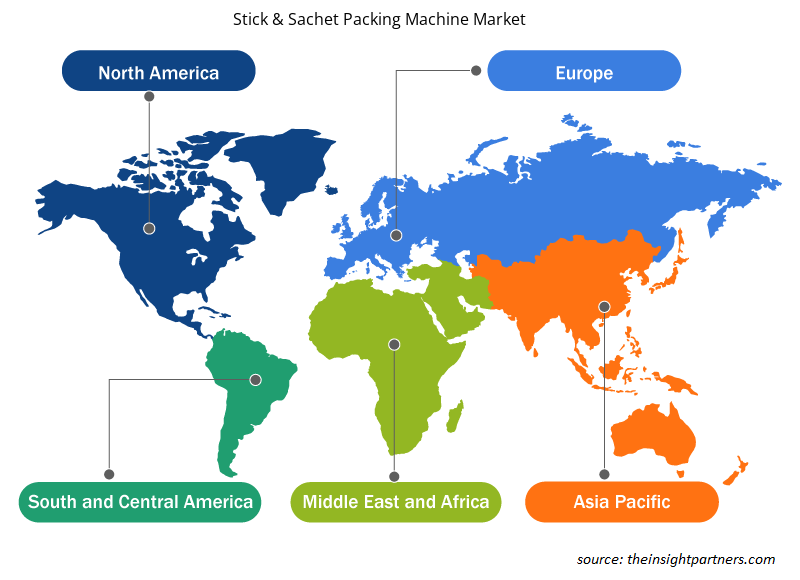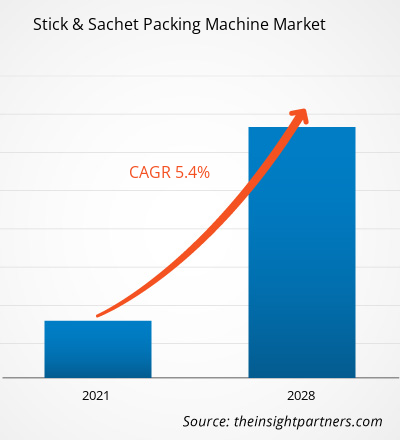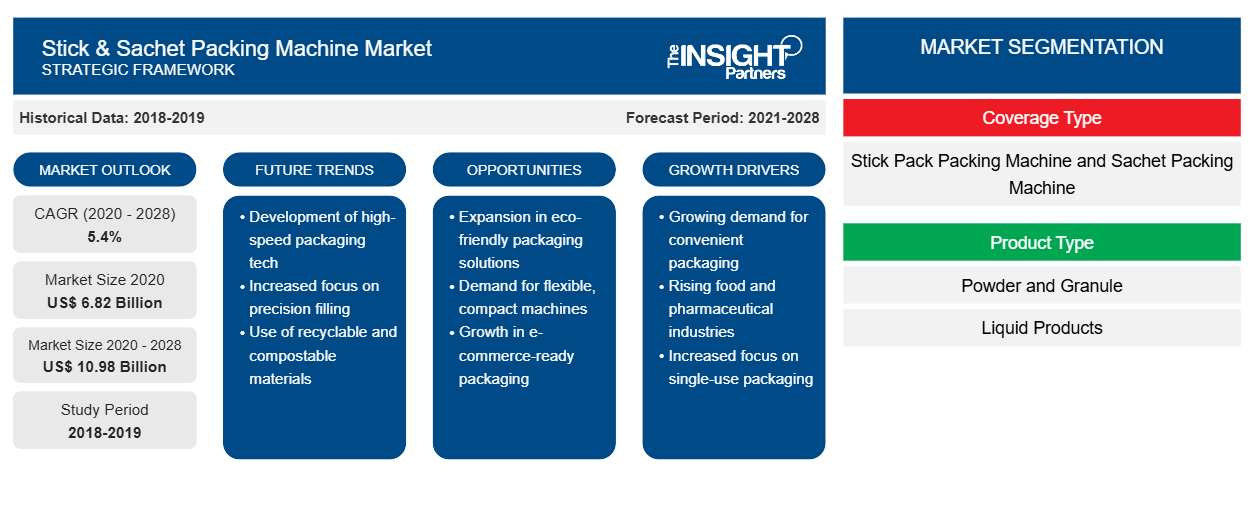スティックおよびサシェ包装機市場は、2020年に68億1,938万米ドルと評価され、2028年までに109億7,892万米ドルに達すると予想されています。予測期間中、5.4%のCAGRを記録すると推定されています。CAGR of 5.4% during the forecast period.
急速な世界的な工業化、パッケージ製品に対する消費者の嗜好の高まり、食品・飲料業界の成長、スマートメンテナンスサービスの提供への重点の高まり、および高度なパッケージングプロセスの最適化は、予測期間中にこの市場の成長を後押しする可能性のあるいくつかの要因です。上記の予測では、電子商取引業界の進化と強化された流通チャネルの普及により、世界のスティックおよびサシェ包装機市場の成長に多くの機会が提供されています。
世界のスティックおよびサシェ包装機市場のエコシステムにおける主要な利害関係者は、原材料サプライヤー、スティックおよびサシェ包装機メーカー、およびエンドユーザーです。原材料サプライヤーは、鋼、軟鋼、プラスチック、ガラス強化プラスチック (GRP)、鉄金属など、さまざまな金属を提供するため、市場の最初の利害関係者です。これらの材料は、コンポーネントの品質を向上させ、パフォーマンスと寿命を向上させます。
要件に合わせてレポートをカスタマイズする
このレポートの一部、国レベルの分析、Excelデータパックなど、あらゆるレポートを無料でカスタマイズできます。また、スタートアップや大学向けのお得なオファーや割引もご利用いただけます。
-
このレポートの主要な市場動向を入手してください。この無料サンプルには、市場動向から見積もりや予測に至るまでのデータ分析が含まれます。
COVID-19パンデミックがスティック&サシェ包装機市場に与える影響
COVID-19の流行は世界中の製造企業に悪影響を及ぼしましたが、世界のスティック&サシェ包装機市場は比較的影響を受けていません。包装会社の大多数は生産能力を増強してフル稼働していますが、生産量の増加を計画している会社もあります。一方、主要メーカーは、新しい技術を使用して機器を標準化し、市場での販売を促進する計画を立てています。
さらに、中国、北イタリア、ドイツ、米国など、影響を受けたほとんどの国では生産プロセスが順調に進んでおり、世界のスティック&サシェ包装機市場の成長を支えています。
スティック&サシェ包装機の世界市場洞察
総合設備効率(OEE)技術OEE) Technique
包装機械を上流の製造プロセスと統合する必要性から、いくつかの分野で自動化技術が開発されました。総合設備効率 (OEE) 技術は、包装プロセスを制御するためのリーン包装操作で使用されます。包装された食事、継続的な投薬と治療、ブランド製品への高額な支出に対するニーズの増加により、リーン包装操作は現在広く使用されており、世界的なスティックおよびサシェ包装機械市場の拡大を加速しています。さらに、インド、インドネシア、中国、米国の電子商取引企業はリーン包装の実践を導入しており、スティックおよびサシェ包装機械の需要を大幅に高めています。
フレキシブル包装は、他の種類の包装よりも人気が高まっています。電子商取引、デジタル印刷、持続可能性などの市場開発と成長の原動力で構成されています。顧客は、フレキシブル包装によって可能になる独自の製品機能に対して、プレミアム価格を支払う用意があります。フレキシブル包装協会によると、北米の消費者の 60% 以上が、製品保護、輸送のしやすさ、サプライ チェーンの効率性など、具体的で機能的な包装の利点に対して、より多くを支払う用意があります。このような要因により、スティックおよびサシェ包装機市場が拡大すると予想されます。
タイプ別グローバルスティック&サシェ包装機市場分析
タイプに基づいて、世界のスティック&サシェ包装機市場は、スティックパック包装機とサシェ包装機に分類されます。スティックパック包装機セグメントは、2020年に40億2,608万米ドルと評価され、2028年までに66億8,656万米ドルに達すると予測されており、予測期間中に5.7%のCAGRで増加します。
製品タイプ別のグローバルスティック&サシェ包装機市場の洞察
製品タイプに基づいて、世界のスティック&サシェ包装機市場は、粉末&顆粒、液体製品、その他に分類されます。粉末および顆粒セグメントは、2020年に55.6%のシェアで市場をリードしました。さらに、2028年までに市場全体の57.3%を占めると予想されています。
スティック&サシェ包装機
スティック&サシェ包装機市場の地域別洞察
予測期間を通じてスティック&サシェ包装機市場に影響を与える地域的な傾向と要因は、Insight Partners のアナリストによって徹底的に説明されています。このセクションでは、北米、ヨーロッパ、アジア太平洋、中東、アフリカ、南米、中米にわたるスティック&サシェ包装機市場のセグメントと地理についても説明します。

- スティック&サシェ包装機市場の地域別データを入手
スティック&サシェ包装機市場レポートの範囲
| レポート属性 | 詳細 |
|---|---|
| 2020年の市場規模 | 68.2億米ドル |
| 2028年までの市場規模 | 109.8億米ドル |
| 世界のCAGR(2020年 - 2028年) | 5.4% |
| 履歴データ | 2018-2019 |
| 予測期間 | 2021-2028 |
| 対象セグメント |
補償内容別
|
| 対象地域と国 |
北米
|
| 市場リーダーと主要企業プロフィール |
|
スティック&サシェ包装機市場のプレーヤー密度:ビジネスダイナミクスへの影響を理解する
スティック&サシェ包装機市場は、消費者の嗜好の変化、技術の進歩、製品の利点に対する認識の高まりなどの要因により、エンドユーザーの需要が高まり、急速に成長しています。需要が高まるにつれて、企業は提供を拡大し、消費者のニーズを満たすために革新し、新たなトレンドを活用し、市場の成長をさらに促進しています。
市場プレーヤー密度とは、特定の市場または業界内で活動している企業または会社の分布を指します。これは、特定の市場スペースに、その市場規模または総市場価値に対してどれだけの競合相手 (市場プレーヤー) が存在するかを示します。
スティック&サシェ包装機市場で事業を展開している主要企業は次のとおりです。
- ARANOW パッケージング マシナリー SL
- インジニエリア デ エンバサド バーティカル SL
- IMA-イラパク
- ケルバーAG
- マトリックス パッケージング マシナリー LLC
免責事項:上記の企業は、特定の順序でランク付けされていません。

- スティック&サシェ包装機市場のトップキープレーヤーの概要を入手
エンドユーザーベースのグローバルスティック&サシェ包装機市場の洞察
エンドユーザーに基づいて、世界のスティック&サシェ包装機市場は、食品および飲料、医薬品、化学薬品、化粧品、その他に分かれています。食品および飲料部門は、2020年に26億2,718万米ドルと評価され、2028年までに41億1,879万米ドルに達すると予測されています。
世界のスティック&サシェ包装機市場のプレーヤーは、競争力を維持するために、合併、買収、市場イニシアチブなどのさまざまな戦略を採用しています。主要な市場プレーヤーによる最近の動向をいくつか以下に示します。
- 2021年、ARANOW Packaging Machinery, SLはAlliedFlex Technologiesと提携し、スティックパック包装機械製品ラインを取り扱うことで北米での販売を促進しました。
- 2022年、Syntegon Technology GmbHは、挽いたコーヒー豆と豆を包装するPMX包装機を追加し、コーヒー包装機のポートフォリオを拡大します。PMXマシンは、さまざまな包装形式に使用できます。また、PMXはリサイクル可能な単一材料を処理し、状態監視を通じてエネルギーと材料の使用量を削減します。
世界のスティック&サシェ包装機市場に上場している企業プロファイル
- ARANOW パッケージング マシナリー SL
- インジニエリア デ エンバサド バーティカル SL
- IMA-イラパク
- ケルバーAG
- マトリックス パッケージング マシナリー LLC
- メスパック、SL
- OMAG株式会社
- SmartPac Verpackungsmaschinen GmbH
- シンテゴンテクノロジー株式会社
- ユニバーサルパック株式会社
- 過去2年間の分析、基準年、CAGRによる予測(7年間)
- PEST分析とSWOT分析
- 市場規模価値/数量 - 世界、地域、国
- 業界と競争環境
- Excel データセット
最新レポート
関連レポート
お客様の声
購入理由
- 情報に基づいた意思決定
- 市場動向の理解
- 競合分析
- 顧客インサイト
- 市場予測
- リスク軽減
- 戦略計画
- 投資の正当性
- 新興市場の特定
- マーケティング戦略の強化
- 業務効率の向上
- 規制動向への対応























 無料サンプルを入手 - スティック&サシェ包装機市場
無料サンプルを入手 - スティック&サシェ包装機市場